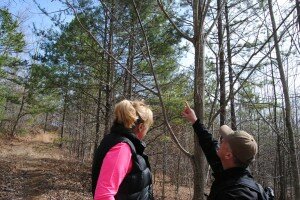

MACED Forester Scott Shouse talks to landowner Noel Watts about the trees on her land.
Long before coal mining dominated eastern Kentucky’s economy, logging was the big business in the region. Stories of log rafts barreling down creeks on their way to the Kentucky River when the water was high and on to the Ohio River still permeate regional folklore. There simply is no way to deny the impact eastern Kentucky’s natural resources have had on the region’s past and present economy.
Our forests may not be as abundant as they once were, but they still can be a driving economic force for the region’s future. MACED’s fourth new strategy brief about the forestry sector explains why:
In 2013, the forest industry generated $12.8 billion for Kentucky’s economy and employed more than 27,500 people statewide. In eastern Kentucky, the industry employed more than 5,700 people in 320 businesses in 2011. Pulaski County’s sizable cluster of wood and paper products manufacturers employs more than 1,500 people.
In addition to those promising figures, the housing market – the recent crash of which hit the wood products sector hard – is beginning to rebound, the price of hardwood logs is increasing, and the sustainable wood products sector has seen promising growth in recent years. The MACED report points out that “with the right training and technical assistance, eastern Kentucky’s many wood products manufacturers can take advantage of the growing market demand for sustainable wood products.”
The economic potential of eastern Kentucky’s forests is not just about wood products manufacturing. From the report:
Healthy forests act as “carbon sinks,” crucial for combating climate change. And eastern Kentucky’s headwater streams are the source of drinking water for much of the rest of the state. Programs that pay landowners to protect their forests ensure that the many benefits of healthy forests are secured for the long term. The Appalachian Carbon Partnership connects family forest owners with the carbon offset market, which pays them for protecting their forest land.
But even with these positive gains, the forestry sector is still struggling. A legacy of poor management practices, coupled with disease and invasive species, has reduced the quality of eastern Kentucky’s hardwoods. In fact, the percentage of high-quality trees in the state had declined by 38 percent between 2004 and 2011. Several things can be done to remedy this, MACED says, including releasing Abandoned Mine Lands Funds to better support reforestation on former mined land, increasing the amount of technical assistance available to landowners and wood products manufacturers, and restoring funding to the Division of Forestry so they can better assist landowners and enforce best management practices.
MACED has maintained that the region must rely on its assets to propel itself into the future, and one of its assets with one of the highest levels of potential is the region’s forests. There needs to be a shift in how we think about their value, and in the level of investment we place in them. As with many promising sectors, we must harken back to the roots of forestry in the region and morph the best parts of it into a 21st Century economic driver.